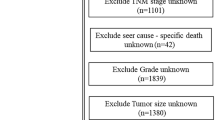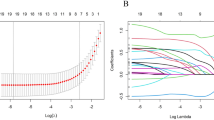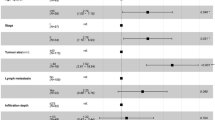Abstract
This study applied advanced machine learning techniques, widely considered as the most successful method to produce objective to an inferential problem of recurrent cervical cancer. Traditionally, clinical diagnosis of recurrent cervical cancer was based on physician’s clinical experience with various risk factors. Since the risk factors are broad categories, years of clinical study and experience have tried to identify key risk factors for recurrence. In this study, three machine learning approaches including support vector machine, C5.0 and extreme learning machine were considered to find important risk factors to predict the recurrence-proneness for cervical cancer. The medical records and pathology were accessible by the Chung Shan Medical University Hospital Tumor Registry. Experimental results illustrate that C5.0 model is the most useful approach to the discovery of recurrence-proneness factors. Our findings suggest that four most important recurrence-proneness factors were Pathologic Stage, Pathologic T, Cell Type and RT Target Summary. In particular, Pathologic Stage and Pathologic T were important and independent prognostic factor. To study the benefit of adjuvant therapy, clinical trials should randomize patients stratified by these prognostic factors, and to improve surveillance after treatment might lead to earlier detection of relapse, and precise assessment of recurrent status could improve outcome.
Similar content being viewed by others
References
Parkin DM, Bray FI, Devesa SS (2001) Cancer burden in the year 2000: the global picture. Eur J Cancer 37:S4–S66
Goldie SJ, Kuhn L, Denny L, Pollack A, Wright T (2001) Policy analysis of cervical cancer screening strategies in low-resource setting: clinical benefits and cost effectiveness. J Am Med Assoc 285:3107–3115
Delgado G, Bundy B, Zaino R, Sevin BU, Creasman WT, Major F (1990) Prospective surgical—pathological study of disease-free interval in patients with stage Ib squamous cell carcinoma of the cervix: a gynecologic oncology group study. Gynecol Oncol 38:352–357
Lai CH, Hong JH, Hsueh S (1999) Preoperative prognostic variables and the impact of postoperative adjuvant therapy on the outcomes of stage IB or II cervical carcinoma patients with or without pelvic lymph node metastases. Cancer 85:1537–1546
Waggoner SE (2003) Cervical cancer. Lancet 361:2217–2225
Berek JS, Hacker NF (2005) Practical gynaecologic oncology. Lippincott Williams & Wilkins, New York
Kamura T, Tsukamoto N, Tsuruchi N, Saito T, Matsuyama T, Akazawa K (1992) Multivariate analysis of the histopathologic prognostic factors of cervical cancer in patients undergoing radical hysterectomy. Cancer 69:181–186
Grisaru DA, Covens A, Fransen E, Chapman W, Shaw P, Colgan T (2003) Histopathologic score predicts recurrence free survival after radical surgery in patients with stage IA2-IB1–2 cervical carcinoma. Cancer 97:1904–1908
Ho SH, Jee SH, Lee JE, Park JS (2004) Analysis on risk factors for cervical cancer using induction technique. Expert Syst Appl 27(1):97–105
Thangavel K, Jaganathan PP, Easmi PO (2006) Data mining approach to cervical cancer patients analysis using clustering technique. Asian J Inf Technol 5(4):413–417
Louie KS, de Sanjose S, Mayaud P (2009) Epidemiology and prevention of human papillomavirus and cervical cancer in sub-Saharan Africa: a comprehensive review. Trop Med Int Health 14(10):1287–1302
Kim HS, Park NH, Kang SB (2008) Rare metastases of recurrent cervical cancer to the pericardium and abdominal muscle. Arch Gynecol Obstet 278:479–482
Kruppa J, Ziegler A, König IR (2012) Risk estimation and risk prediction using machine-learning methods. Hum Genet 131(10):1639–1654
Hu YH, Wu F, Lo CL, Tai CT (2012) Predicting warfarin dosage from clinical data: a supervised learning approach. Artif Intell Med 56(1):27–34
Van Belle V, Pelckmans K, Van Huffel S, Suykens JAK (2011) Support vector methods for survival analysis: a comparison between ranking and regression approaches. Artif Intell Med 53(2):107–118
Vapnik VN (2000) The nature of statistical learning theory. Springer, Berlin
Huang GR, Zhu QY, Siew CX (2006) Extreme learning machine: theory and applications. Neurocomputing 70:489–501
Gomathi M, Thangaraj P (2011) A computer aided diagnosis system for lung cancer detection using machine learning technique. Eur J Sci Res 51:260–275
Malar E, Kandaswamy A, Chakravarthy D, Giri Dharan A (2012) A novel approach for detection and classification of mammographic microcalcifications using wavelet analysis and extreme learning machine. Comput Biol Med 42:898–905
Vanneschi L, Farinaccio A, Mauri G, Antoniotti M, Provero P, Giacobini M (2011) A comparison of machine learning techniques for survival prediction in breast cancer. BioData Mining 4(1):12
Bharathi A, Natarajan AM (2012) Efficient classification of cancer using support vector machines and modified extreme learning machine based on analysis of variance features. Am J Appl Sci 8(12):1295–1301
Hsu CW, Lin CJ (2002) A comparison of methods for multiclass support vector machines. IEEE Trans Neural Netw 13(2):415–425
Larose DT (2005) Discovering knowledge in data: an introduction to data mining. Wiley, New Jersey
Quinlan JR (1993) C4.5: programs for machine learning. Morgan Kaufinann, San Mateo
Acknowledgments
This work is supported by the Chung Shan Medical University Hospital: CSH-2012-C-012.
Author information
Authors and Affiliations
Corresponding author
Rights and permissions
About this article
Cite this article
Tseng, CJ., Lu, CJ., Chang, CC. et al. Application of machine learning to predict the recurrence-proneness for cervical cancer. Neural Comput & Applic 24, 1311–1316 (2014). https://doi.org/10.1007/s00521-013-1359-1
Received:
Accepted:
Published:
Issue Date:
DOI: https://doi.org/10.1007/s00521-013-1359-1




